by Tim Mosso
Clean-sheet watchmaking has its advantages. Reservoir Watch was founded in 2016, launched its first products in 2017, and entered its first watch into the Grand Prix d’Horlogerie de Genève (GPHG) in 2018.
Absent any history or gambit to appropriate a dead brand name, Reservoir has been able to channel its energies into inventive design, high value for money, and a well-rounded model line.
It’s French. And Swiss.
Before discussing the Reservoir Supercharged Classic in depth, it’s worthwhile to review what Reservoir Watches is and is not.
Reservoir follows the Bell & Ross game plan of Swiss manufacturing and Parisian planning. The manufacture of Reservoir watches takes place in La Chaux-de-Fonds, Switzerland; design and the business office reside in Paris.
Officially, Reservoir is a Parisian design house, and the executive team boasts no fewer than three François (François-es?) to hammer home the point.
CEO and founder François Moreau, a banker by trade, is the principal force behind the Reservoir brand. He and his team have standardized one set of features across all Reservoir products: automatic winding, a power reserve indicator, a retrograde minute scale, and a jump-hour display.
Five collections are spread over three themes: “marine,” “aeronautics,” and “cars.” While that array amounts nearly to a parody of the average watch collector’s interest pool, there is truth in caricature, and the three François appear to have hit a bullseye from a marketing standpoint.
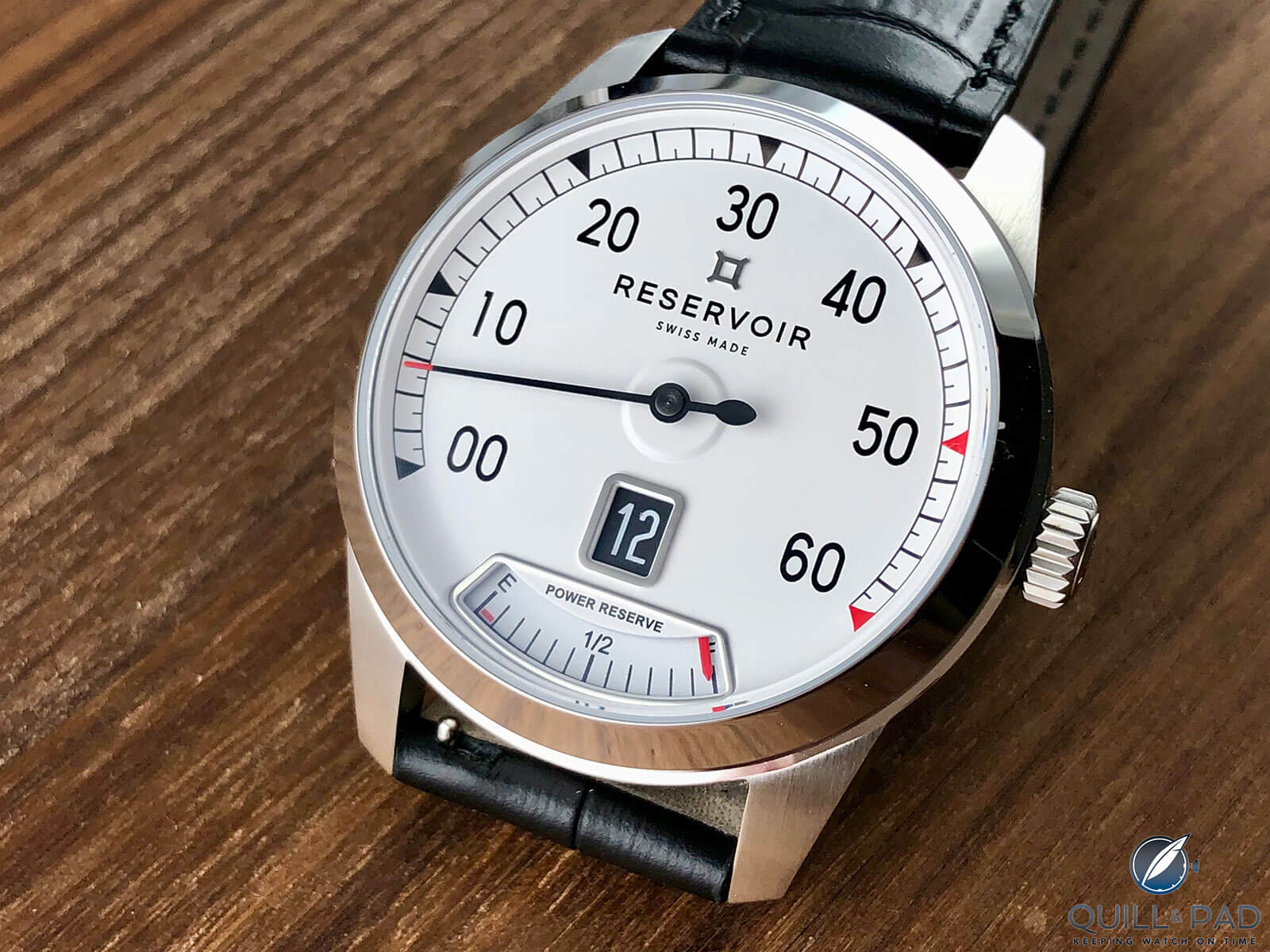
Reservoir Watch Supercharged Classic
Peers and price points: un-equals
But Reservoir expressly targets a price range and a buyer remote from the haut-de-gamme likes of De Bethune, Hautlence, and Bulgari (née Gérald Genta) that populate the jump-hour and retrograde display niche. Most Reservoir watches – the Supercharged Classic included – retail for under $5,000, and the premise appears sound; this is a ton of complication for Tudor Black Bay money.
Arguably, only Meistersinger and Azimuth have invested as much energy in alternative time displays at such a price point, and even then comparable Azimuth watches generally exceed the $3,900 MSRP of this Reservoir Supercharged.
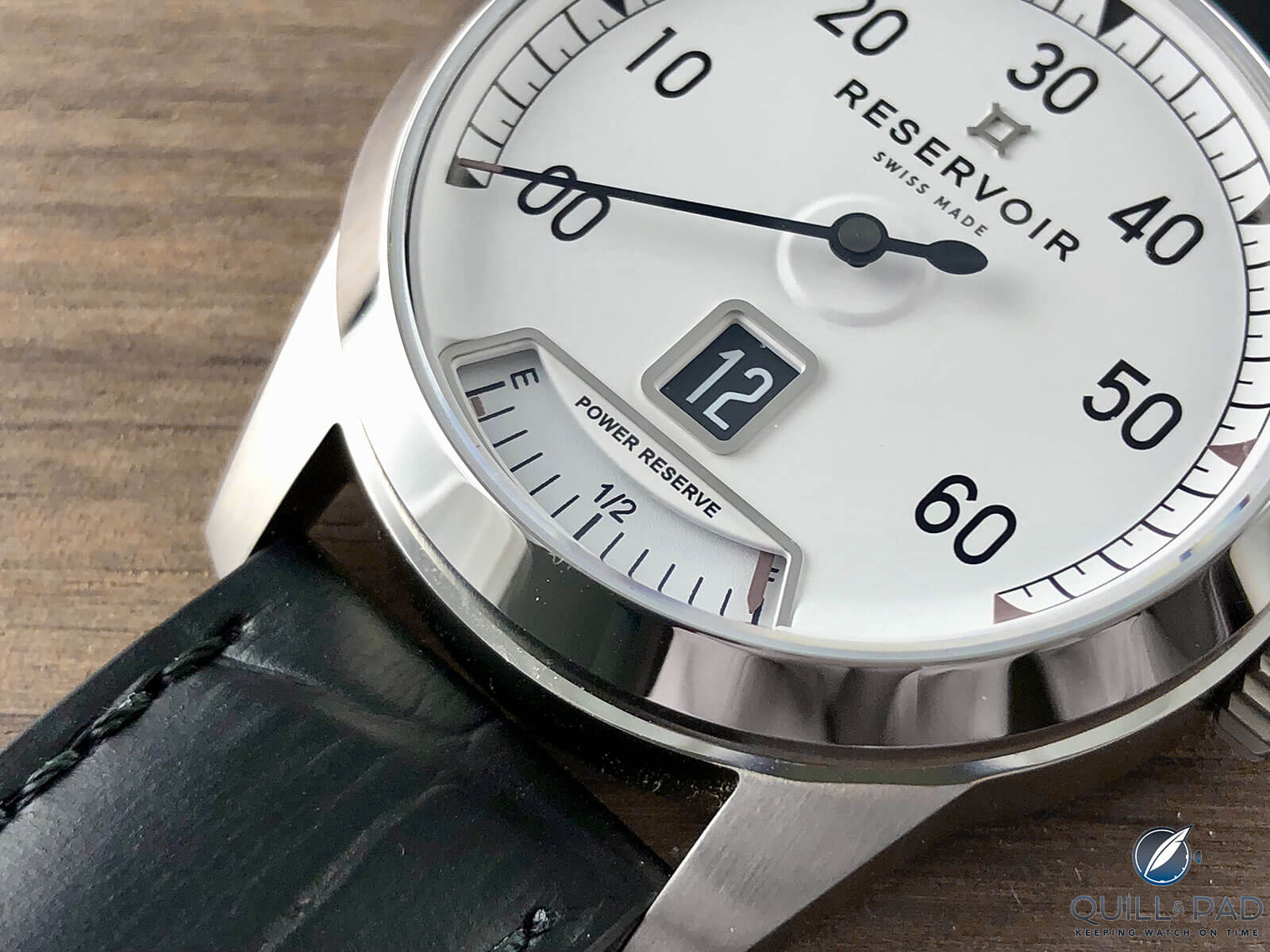
Reservoir Watch Supercharged Classic
A different take on “automotive” dials
Reservoir’s design is straightforward in concept but nuanced in execution. The instrument-inspired dial of the Supercharged Classic owes a nod to the prior work of Bell & Ross and Giuliano Mazzuoli in this modality, but Reservoir combines the gauge aesthetic with functions beyond orthodox three-hand time.
As part of the Reservoir’s skeuomorphic design scheme, the retrograde hand plays the role of indicator on a vintage sports car tachometer or speedometer, and the power reserve emulates the fuel gauge. A digital jump-hour display rests between the two and provides a sharp “snap” concurrent with the retrograde at the turn of the hour.
Design of the Supercharged Classic sub-model expressly relies upon the interior features of sports and racing cars built between 1930 and 1960. While the 2018 GPHG Challenge category-shortlisted Reservoir Longbridge British Racing Green explicitly references the speedometer of a 1960s Austin Mini, the Classic is not model-specific.
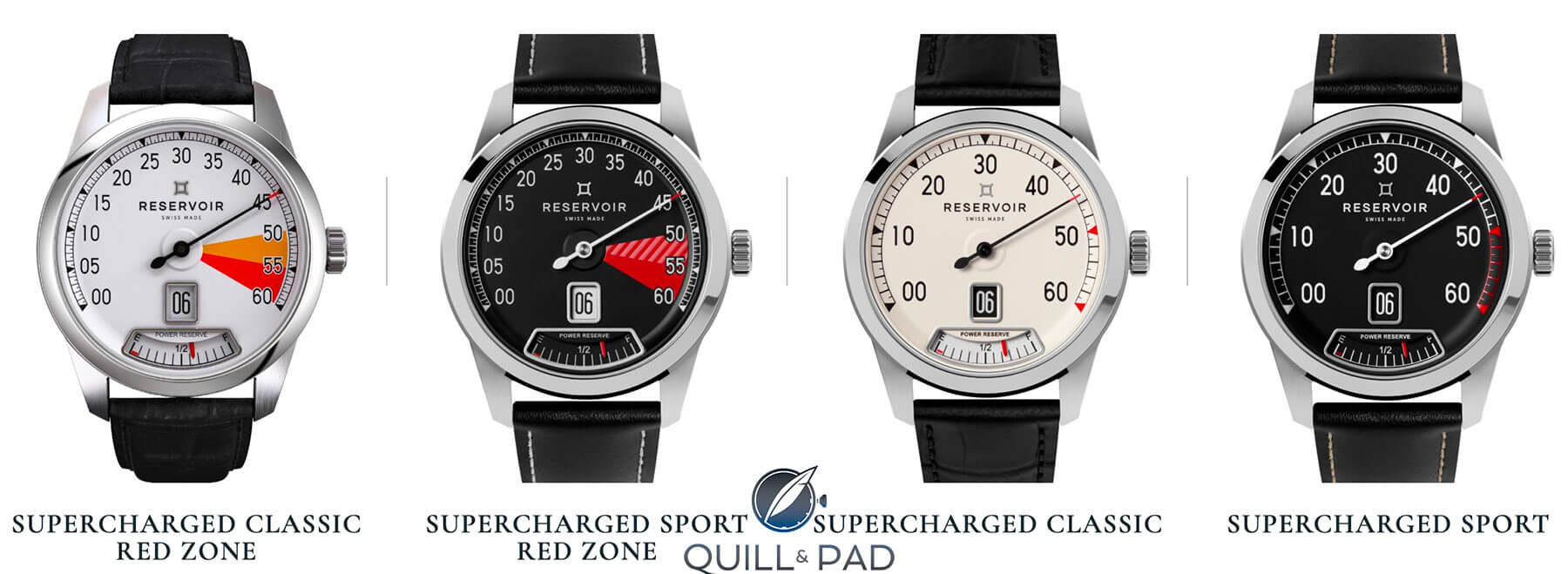
Reservoir Watch Supercharged collection
Details matter: dial depth and graphics
The outer edge of the Supercharged Classic’s dial features a flange-like slope bearing the retrograde minute scale. This concave feature, which grants the dial an extra measure of depth, is calibrated only across 240 degrees to remind the owner that automotive gauges feature a “dead zone” at their bases.
Jaeger-LeCoultre employed the same discontinuous dial graphics, albeit at a much higher price point, in its 2004-2014 Amvox series.
While Jaeger-LeCoultre was fixated expressly on David Brown-era Aston Martins, Reservoir’s unspoken – but heavily implied – inspiration appears to be the Smiths gauges featured on 1950s-1960s Jaguar automobiles. Alongside the Supercharged flange design, the vertical orientation and font of the Arabic numerals allude to a Smiths instrument without impinging on Bremont’s evident monopoly on Jaguar watch crossovers.
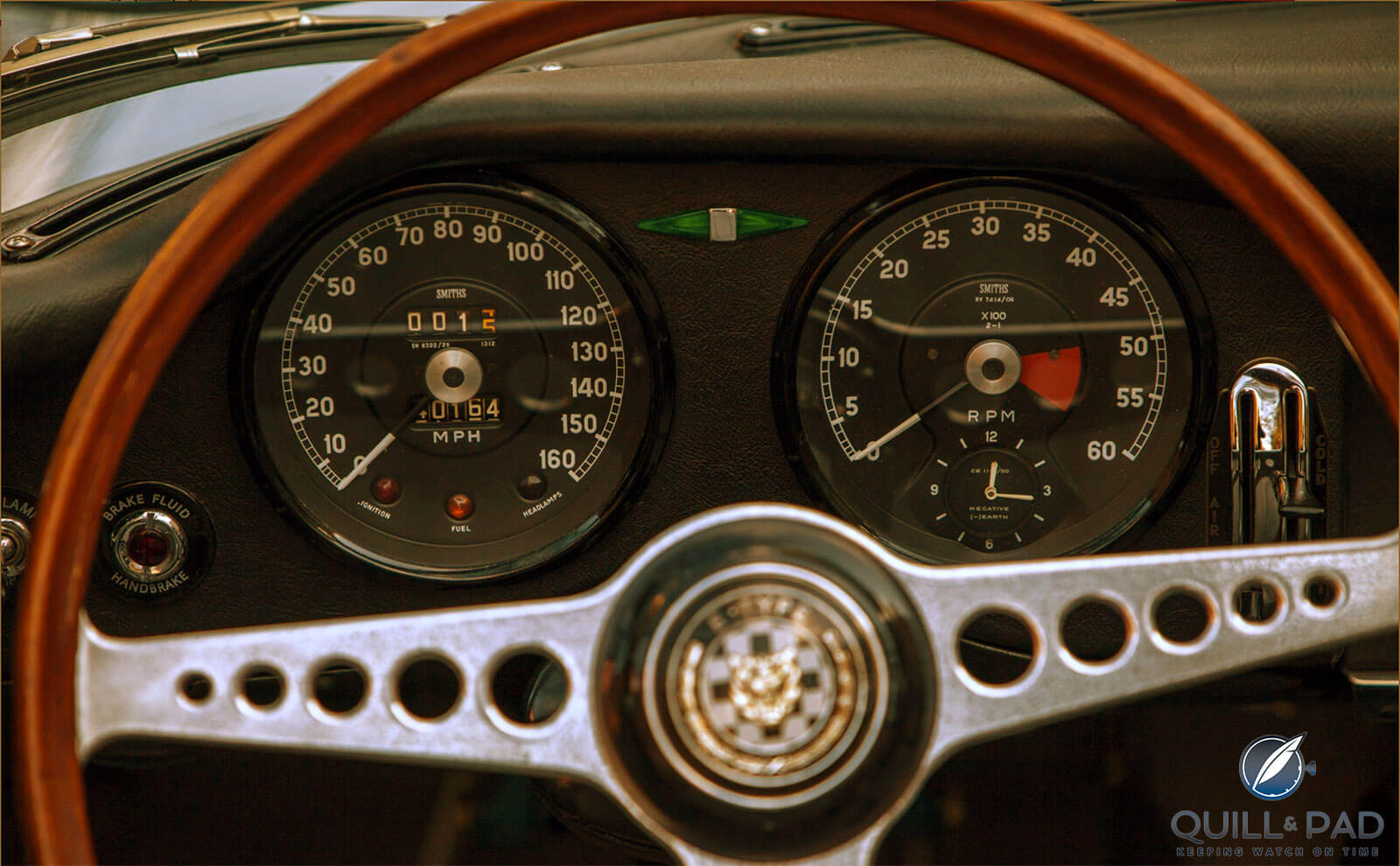
Smiths gauges on a vintage Jaguar (photo courtesy Petrolicious.com)
Lending – and extending – a hand
More attention to detail is evident at the center of the dial. An elevated plinth beneath the minute hand parallels the same structure beneath the pivot of a dashboard gauge – Smiths again – and helps to break up the otherwise flat expanse of the dial center. While proper hand length can be a contentious subject among watch buyers, Reservoir’s design team wisely erred on the side of delightful excess.
The Reservoir Supercharged Classic’s sports a graceful and generous bob-counterweighted needle-like minute hand in flat black; its gossamer expanse ends just short of the outer edge of the minutes sector.
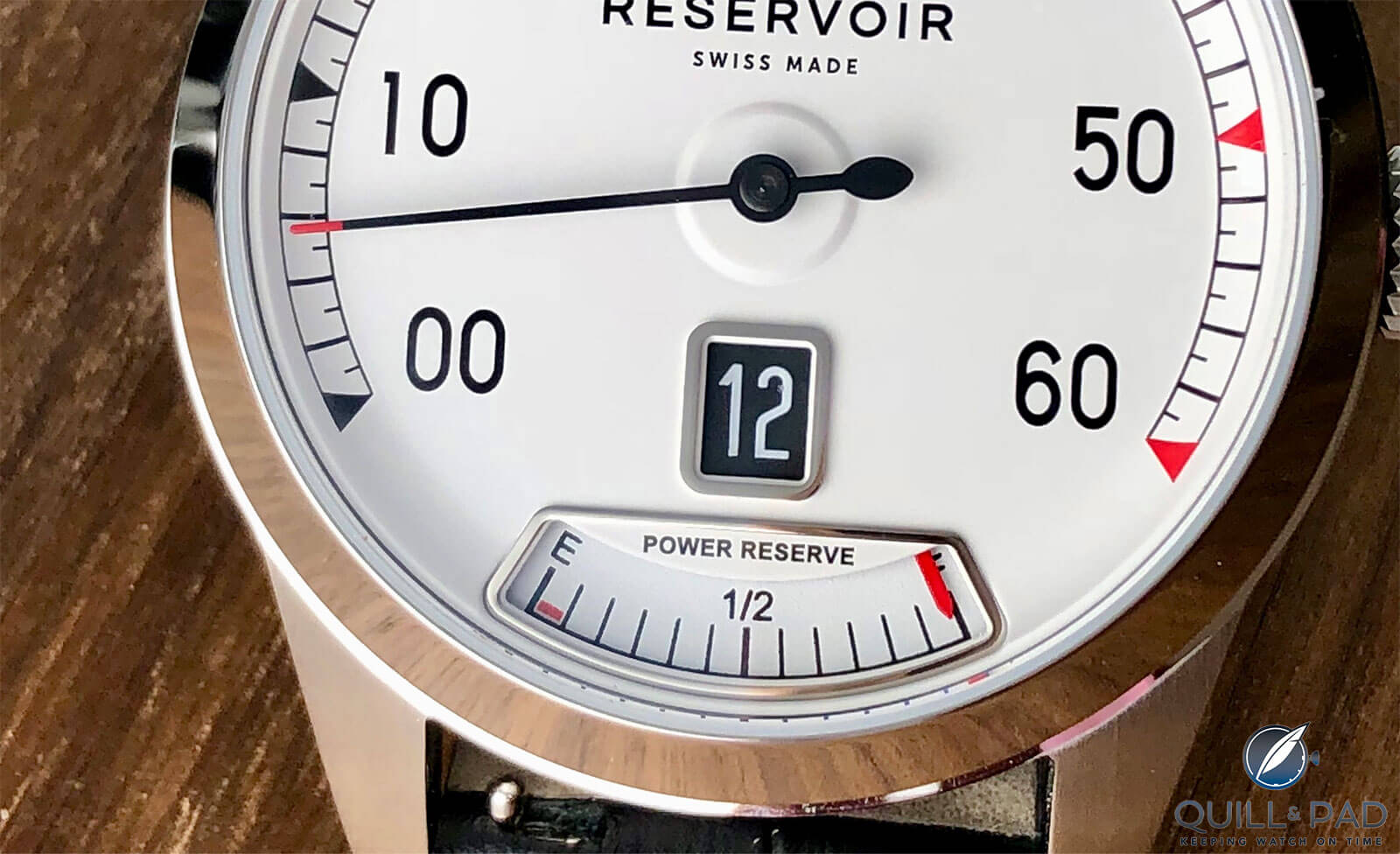
Jump hour and power reserve of the Reservoir Watch Supercharged Classic
At 6 o’clock, the power reserve indicator breaks cleanly from the dial flange. This could have been a jarring feature, but the sculpted transition from flange to metallic bezel keeps the junction of the structures properly refined. This melding of shapes reflects a plan – not an accident.
A similar metal bezel surrounds the jump hour, and its combined effect with the power reserve bezel is to convey the impression of a more expensive watch. Within the hour aperture, Reservoir opted for a black display disk with crisp white numerals. Along with a handful of red flourishes, this contrast helps to enliven what could have become a visually numb monotone expanse of dial varnish.
About that dial varnish: Reservoir intended the Classic to convey the march of years in a fashion that the other Supercharged models do not. Although it’s easier to register in person than to photograph, the matte base of this dial is a light off-white crème rather than the harsher chalk white used elsewhere in the collection. In concert with the black scales and red accents, the classic white-black-red sporting tri-tone of innumerable mid-century motorsports chronographs echoes on this Reservoir.
A case study
At 43 mm, the stainless steel case of the Supercharged Classic rests at the midpoint of Reservoir’s size offerings. The rotating-bezel Hydrosphere models measure 45 mm, and the most compact of the Longbridge units span a tidy 39 mm. But to Reservoir’s credit, the designs rather than the sizes of these cases provide the real distinction between collections.
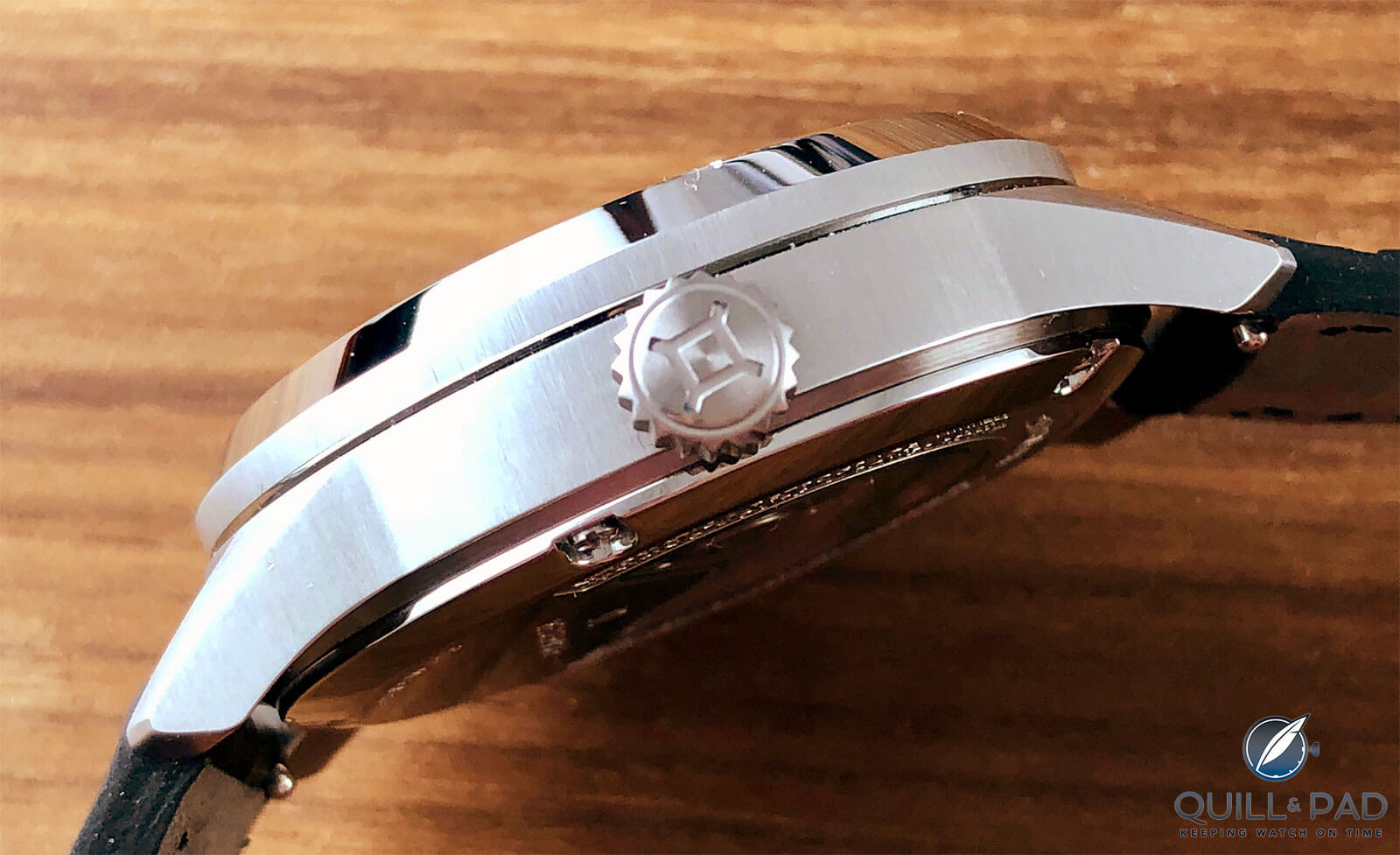
Crown of the Reservoir Watch Supercharged Classic
Case design is where Reservoir most clearly references wristwatch design precedent rather than auto parts. By sculpting vaguely Heuer Carrera-inspired lugs that project forcefully from the case band, the Classic’s designers clearly gleaned more from 1960s design than car tropes.
But Reservoir’s take on the classic Carrera lug is thematic rather than literal; the Supercharged sports a more pronounced break between case and lug than the old Heuer.
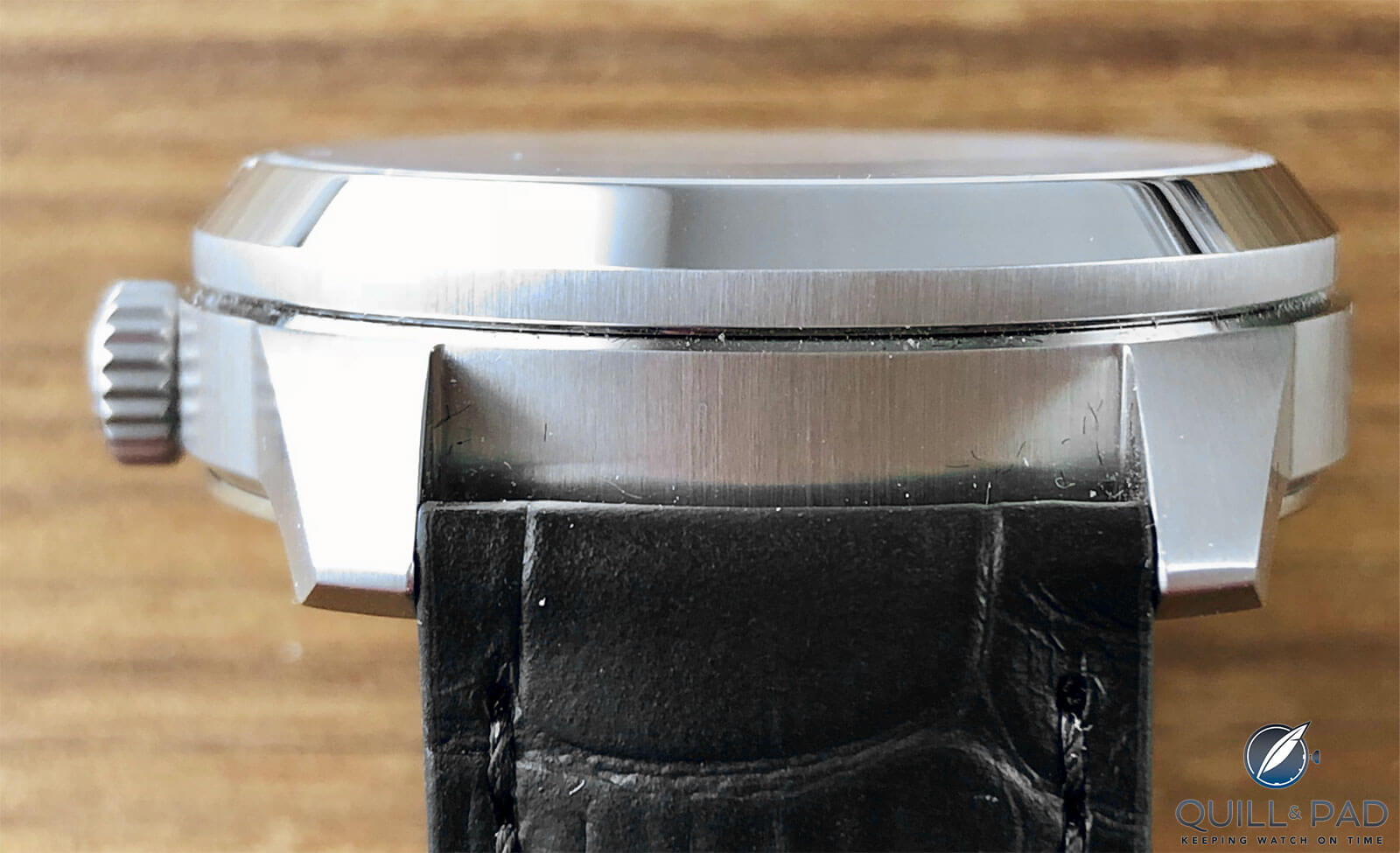
Lugs, case band, and bezel of the Reservoir Watch Supercharged Classic
As with its dial, lug design on this Reservoir sports subtle flourishes that speak to its creators’ eye for nuance. The lug tips are beveled rather than pointed, and the profile of the tip is wedge-shaped rather than squared off.
Conventional case finish dictates polished flanks (e.g., Rolex) or longitudinal satin (e.g., most Omegas); Reservoir opts for the rarely seen vertical satin approach. First, the choice of satin finish on a relatively large watch reflects good taste on the part of the designers, because high polish on 43 mm (and bigger) cases is terminally 2005.
Second, the vertical satin smartly spans the mid-case area to the lateral face of the bezel, a trick that visually unites the two despite a noticeable gap between the structures.
Making a move[ment]
If there’s a true head-scratching angle to the Reservoir Supercharged, it is the Greubel-Forsey-ish surplus of relieved micro text on the case back. It’s downright bizarre.
Given that hardcore watch nerds buy oddball time displays, and these guys – they’re usually guys – tend to photographically recall product specs . . . do you see where I’m going with this?
Why advertise the watch to the true believer who already owns it? Does the buyer need to see the details of his purchase embossed on his skin each time he removes the watch?
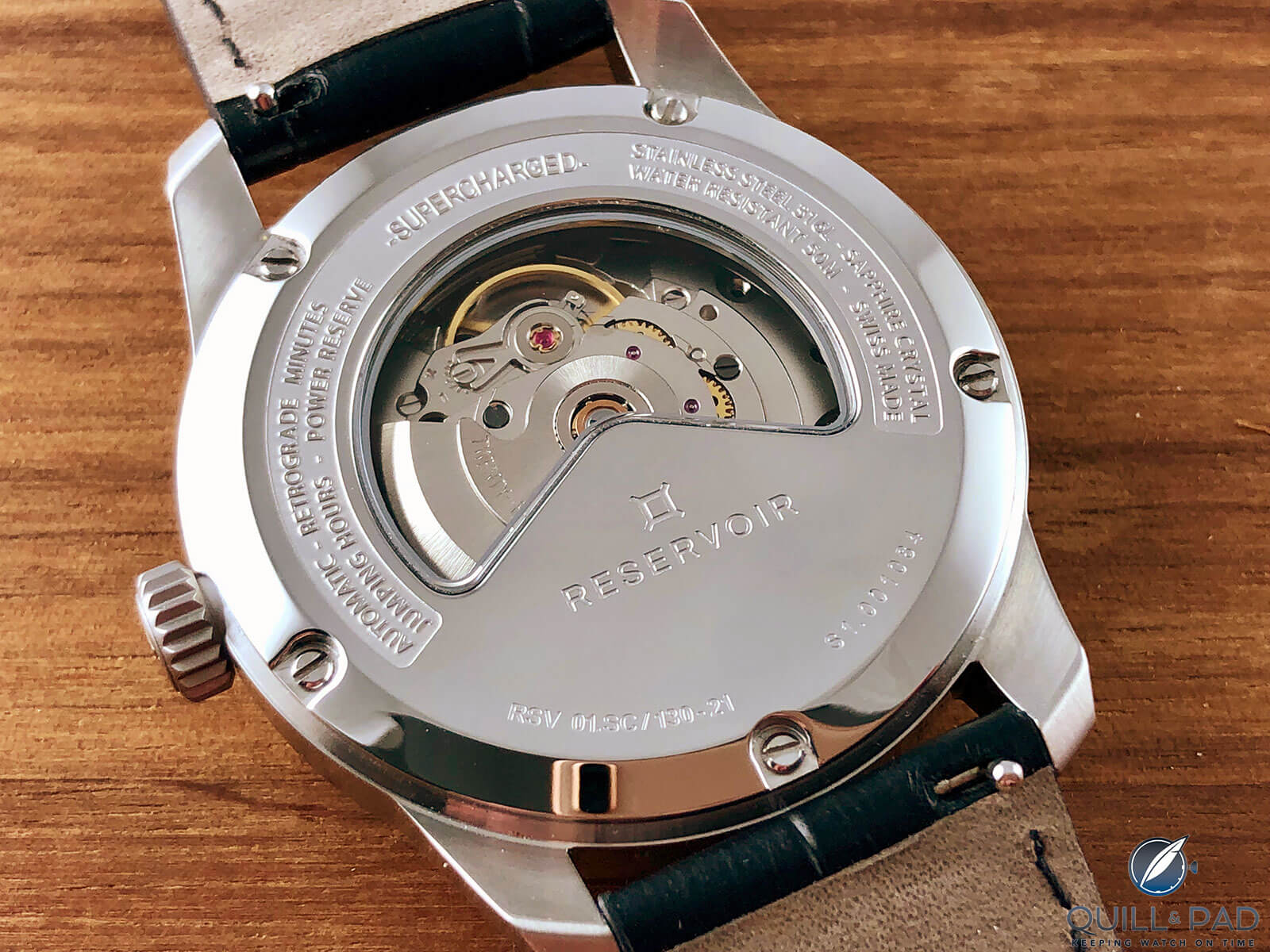
View through the display back of the Reservoir Watch Supercharged Classic
Yawning case back vistas of basic movements feel like a pander rather than goodwill, so Reservoir did well to keep this display window themed and minimal. As with the dial-side minute scale, the sapphire crystal display spans exactly 240 degrees. This is a thoughtful application of parallel design, and it limits observation to the balance, regulator, rotor center, and reversing wheels; these are the only interesting parts of a standard ETA 2824-2.
Mechanically, the Reservoir alternates between elementary and exotic. The genuine ETA tractor caliber is a reassuring and welcome presence in an otherwise unconventional product from a young brand. Beneath that, however, things take a turn for the higher end of horology. A proprietary complication module – Reservoir owns the rights – from movement house Télôs Watch S.A. translates the ETA’s torque to the triple complication’s dial-side output.
Télôs, which is perhaps best-known for creating the Harry Winston Opus 14 of 2015, is an accomplished Swiss specialist in complicated watchmaking. Its ability to make the spectacular everyday-reliable has been established at price points orders of magnitude beyond the cost of this Reservoir.
Technically speaking, roughly 50 percent of what’s inside the case is the 124-part/10-jewel Télôs complication, so there is a great deal of exclusive watchmaking within this Supercharged Classic.
Despite the price point of the Reservoir Supercharged, it includes sufficient Swiss value and local assembly to bear the “Swiss Made” label on its dial. As of 2017, that entails 60 percent Swiss content by value as well as casing, quality control, and final assembly on Swiss soil.
This isn’t to say that peripherals like crystals, clasps, or random case components aren’t outsourced to some extent, but it does offer a comforting distinction between Reservoir and polyglot budget micro brands like Sevenfriday or the latest iteration of Ikepod.
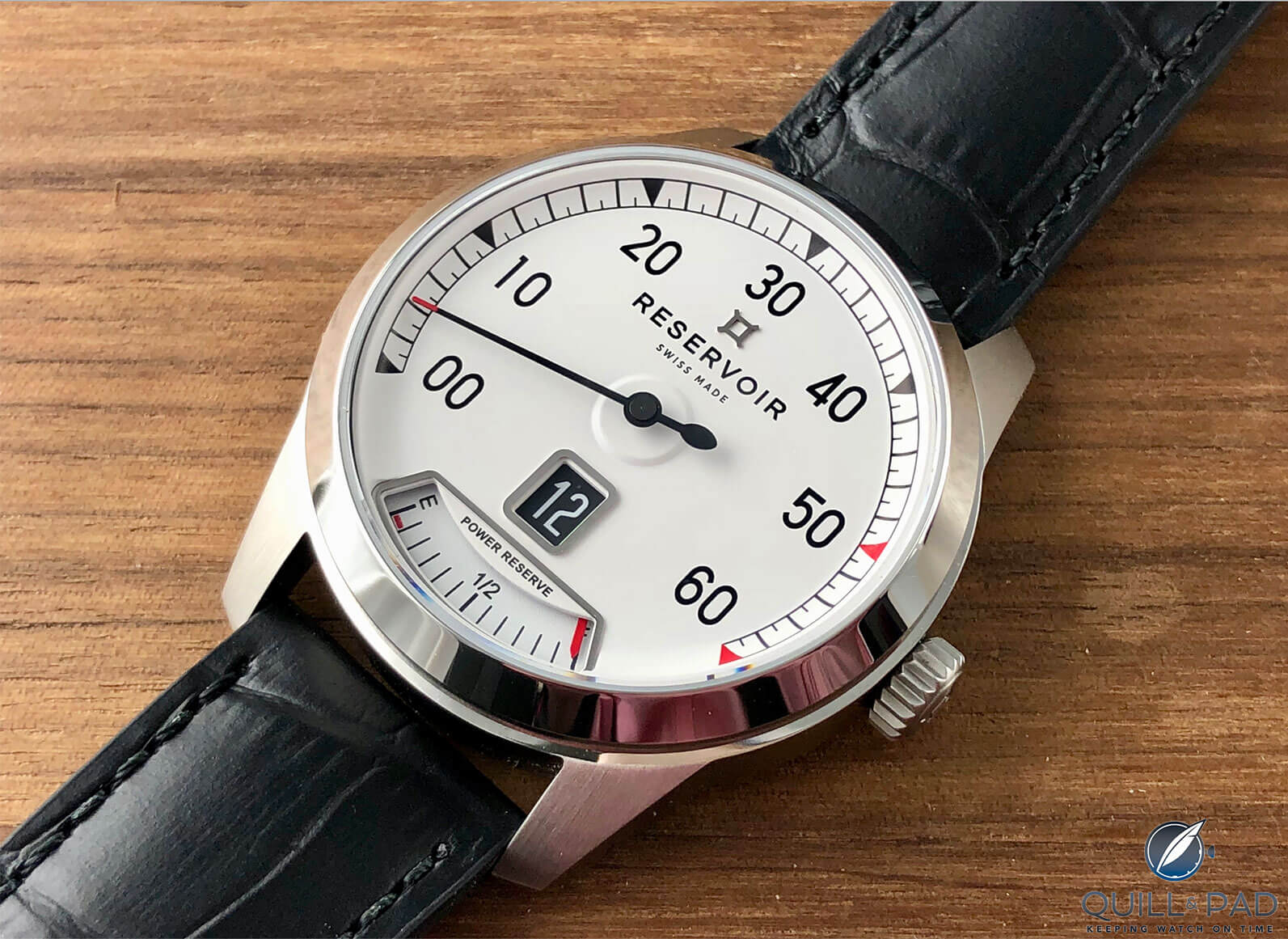
Reservoir Watch Supercharged Classic
La Chaux-de-Fonds-based Télôs handles module construction as well as final assembly and quality control of Reservoir’s timepieces.
Laurent Ferrier, HYT, Richard Mille, and MB&F rely heavily on movement engineering partners to deliver brand-exclusive mechanisms, and it’s easy to see that Reservoir’s development path is both well established and in good company.
Odds and ends
Technically accomplished, accessibly priced, and thoughtfully styled, the Supercharged Classic impresses with its full suite of peripherals. Start with the boxed set, which includes strap tools, a NATO accessory band, and metal hardware for the strap.
Reservoir’s warranty spans three years; the “industry standard,” which you’ll find at brands as varied as Tudor and Patek Philippe, remains two years.
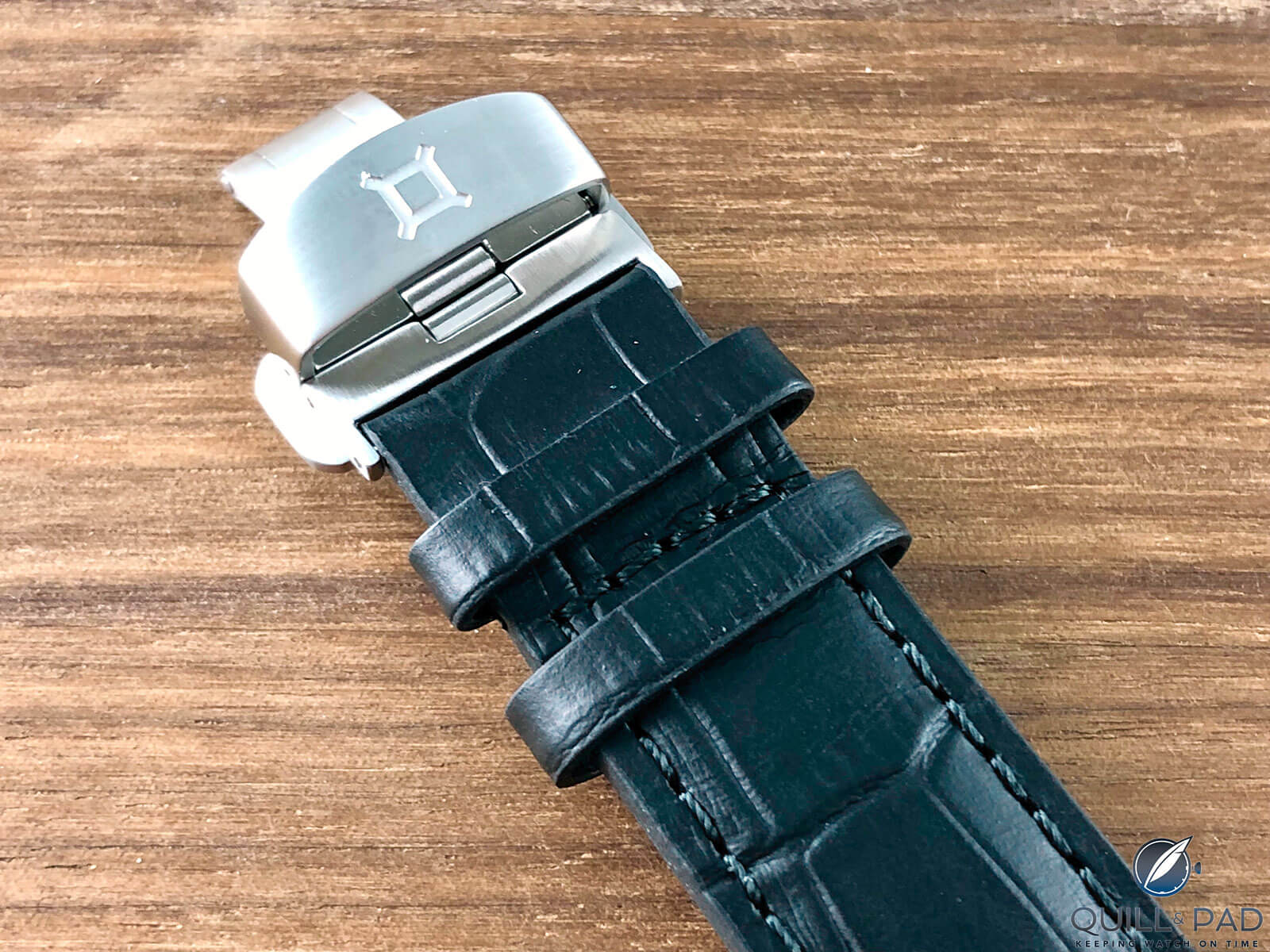
Reservoir Watch Supercharged Classic alligator strap and folding buckle
More added value comes in the form of the strap and clasp. In the sub-$4,000 price class, textile, rubber, or calf leather straps are the norm, so Reservoir surprises with large-scale alligator.

Reservoir Watch Supercharged Classic folding clasp
And there are Patek Philippe-style spring tab releases on this strap so that the owner can remove it without risking the lug finish with a screwdriver or tool. Likewise, this price point usually entails a pin buckle or NATO-style binder. A full steel double deployant with trigger release surpasses expectations.
On the road – and wrist – with the Reservoir Supercharged Classic
The Reservoir experience will vary depending on your model, but all experiences can begin on the company’s website, which sells online and direct. This is refreshingly progressive in an industry that still abhors e-commerce and occasionally forces clients to physically visit an authorized point of sale.
And with Reservoir retail prices more comparable to consumer electronics than most luxury watches, haggling feels less critical. Point-and-click checkout suffices. For those who prefer the in-person experience, Reservoir also works through an international network of authorized dealers.
Significantly, Reservoir is establishing local service partners across international markets, and this initiative should pay significant dividends in servicing speed and ease down the road.
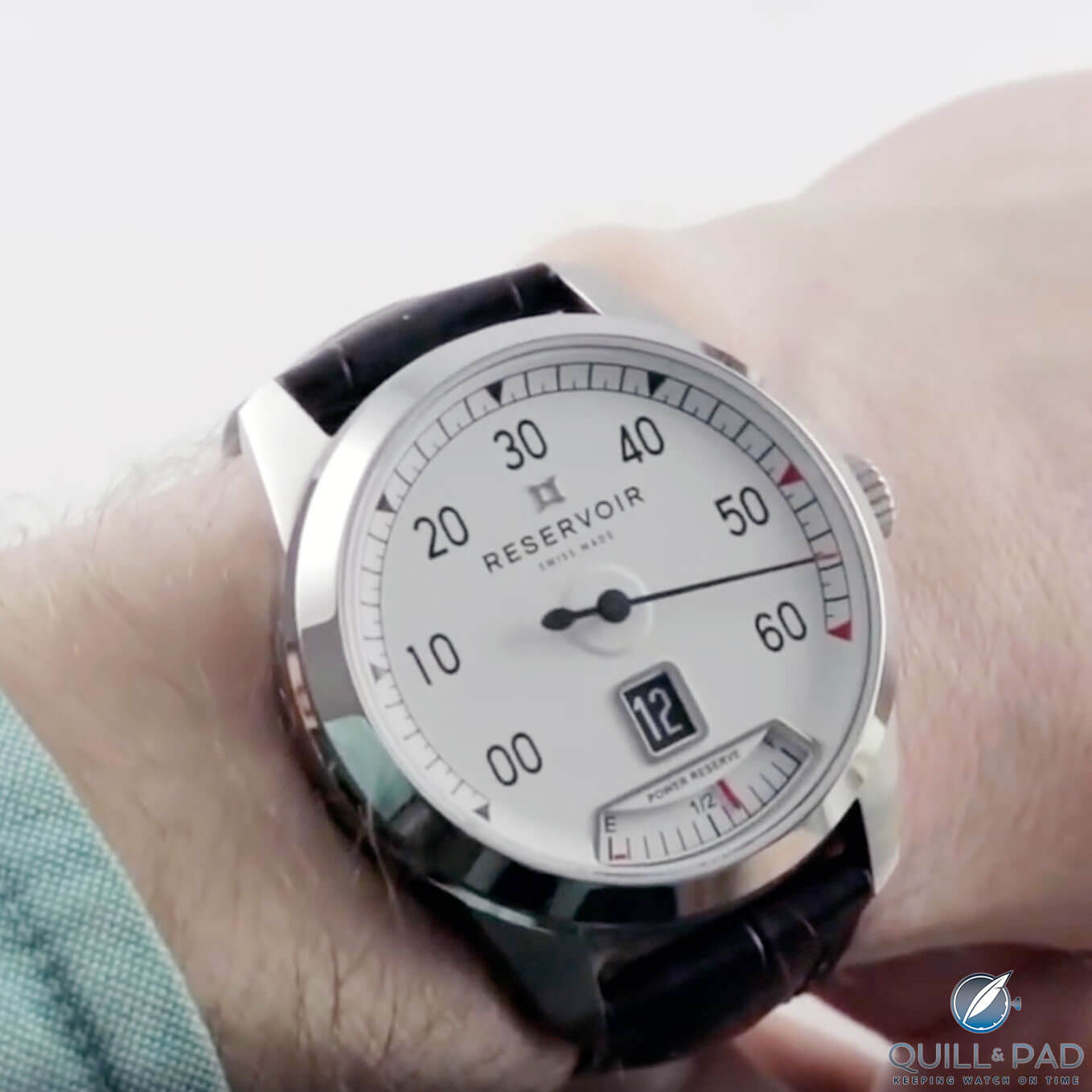
Reservoir Watch Supercharged Classic on the wrist
Once on the wrist, it’s clear that the Supercharged lands on the oversized end of the size spectrum: 43 mm is a borderline dimension that can play “large” or “oversized” depending on lug span and shape.
Those jutting Carrera-style lugs flare 51.4 mm across the wrist, and their shape doesn’t quite contour around the edges of the wrist. Consider a wrist circumference of 15 cm or larger to be mandatory. Any size below that should implore a collector to consider the 39-41.5 mm Longbridge collection.
While the Supercharged is broad, it’s surprisingly thin. Given an ETA 2824, a modular complication, and a deep dial, the measured thickness of 13 mm seems downright miraculous.
For reference, a Rolex Submariner averages 12.6 mm across its various metals. If you can rock a Sub with your cuff, you can be a Reservoir dog.
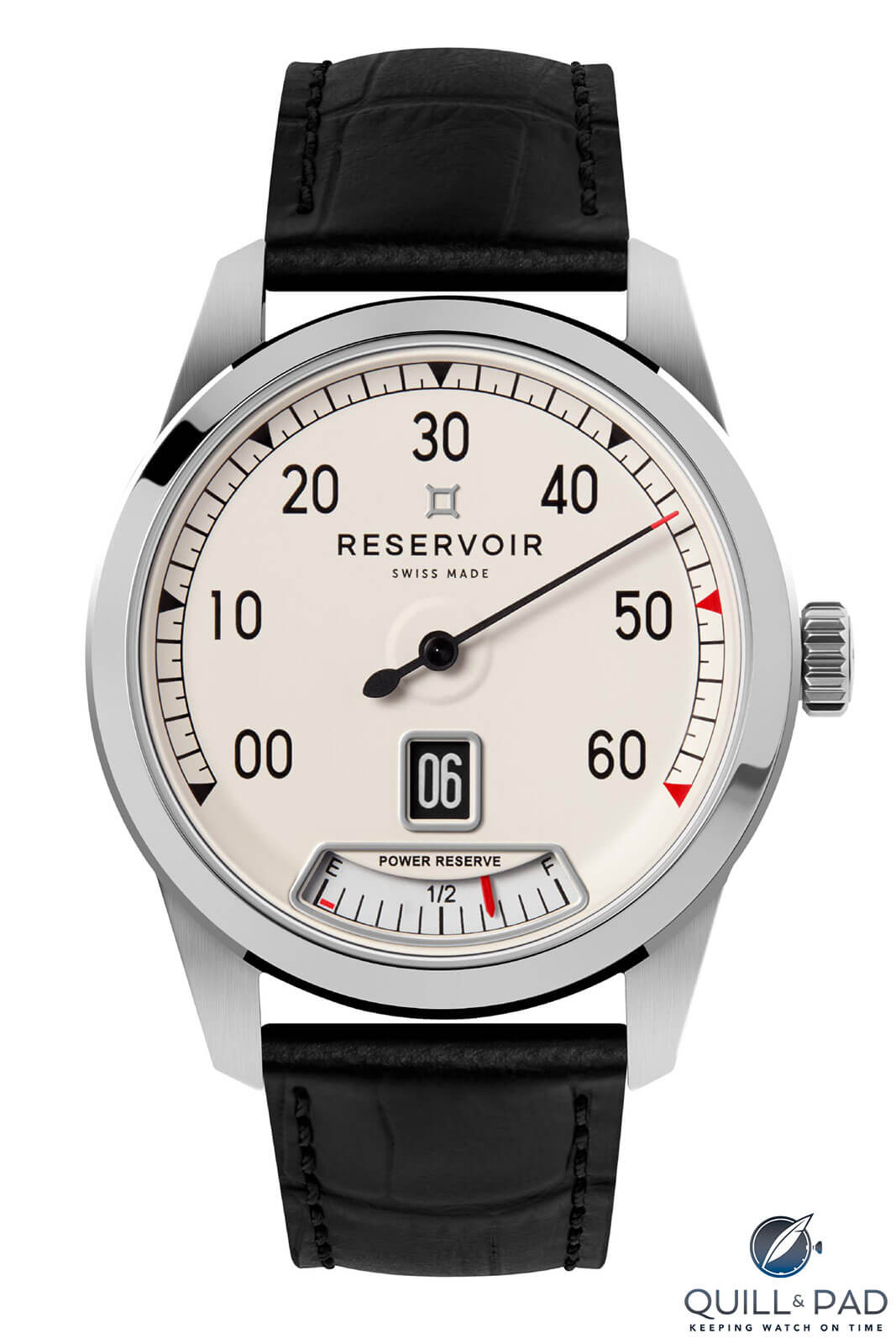
Reservoir Watch Supercharged Classic
Reactions to the watch universally were positive. I encounter an aberrant number of hardcore watch enthusiasts in the course of my work, but this hard-to-please demographic embraced the watch. Comments concerning the price point, design, and complication density dominated discussion of the Classic.
A few of these folks expressed genuine interest in buying an example when told of the price. For this crowd, there may have been something uniquely appealing about a worthwhile watch that doesn’t involve prolonging retirement, Googling the value of redundant organs, or the near-mortgage money often associated with weird time displays from Swiss independents.
Functionally, the only surprise encountered in my time with the Reservoir was the safety system that allows a user to set the retrograde minute bi-directionally without damaging the jump hour.
A 37-hour power reserve means that this is a watch to wear daily or expect to reset. And while the screw-down crown – technically – permits surface swimming, I can’t help but feel that there’s a bit of a daredevil factor in doing so with a 50-meter rating.
Water aside, the only practical constraints were the lack of a constant second display and the absence of any luminescent treatment on the hand or hour disk.
My experience with the Supercharged Classic suggests that the design translates well to the general public. Even without prior discussion of the automotive cues, one of my usual non-enthusiast opinion sources made the connection.

Reservoir Watch Supercharged Classic
Overall, the Reservoir’s look was well-received by the non-watch set. The crowd-pleasing retrograde, jump hour, and sliding power reserve trio drew universal praise . . . and one curious inquiry whether rapidly cycling the retrograde and jump hour would “drain the battery.”
For more information, please visit www.reservoir-watch.com.
Quick Facts Reservoir Supercharged Classic Reference RSV01.SC/130-21
Case: 43 x 13 x 51.4 mm (lug-to-lug), stainless steel
Movement: automatic Caliber ETA 2824-2 base, 37-hour power reserve, 4 Hz/28,800 vph frequency, ETAchron regulation; Télôs Watch S.A.module, exclusive to Reservoir, 10 jewels, 124 parts
Functions: hacking retrograde minutes, jumping hours; power reserve indicator
Accessories: one additional NATO strap and strap tools
Price: $3,900
Remark: three-year warranty
Leave a Reply
Want to join the discussion?Feel free to contribute!





















































This website truly has all the information and facts I needed about this subject and didn’t know
who to ask.
Great article. I was fixated on getting a (relatively) inexpensive jump hour at one point, and it was a battle between Reservoir’s GT Tour and Meistersinger’s Black Line Salthora Meta, before I lost interest and chased another squirrel. There’s an element of bathroom scales to the power reserve on the white Supercharged Classic that put me off that particular model, but if I ever get the bug again I think I’d just go straight ahead and get the GT Tour. Unless life goes very swimmingly, of course: then I’d start hunting for a Vacheron Saltarello.
Just discovered this enticing brand and now know more than I could desire in one superb article. Reservoir is definitely on my short list. Bravo!
Absolutely loved this post! It’s refreshing to see a focus on affordable Swiss quality. The Reservoir Watch’s unique design and features really stand out in a market that often prioritizes luxury over accessibility. I’m definitely considering adding one to my collection!
Great read! I love how Reservoir blends vintage aesthetics with modern mechanics in their watches. It’s refreshing to see a brand that delivers Swiss quality without breaking the bank. The supercharged design truly stands out and feels unique in a market flooded with similar styles. Looking forward to seeing how they evolve!